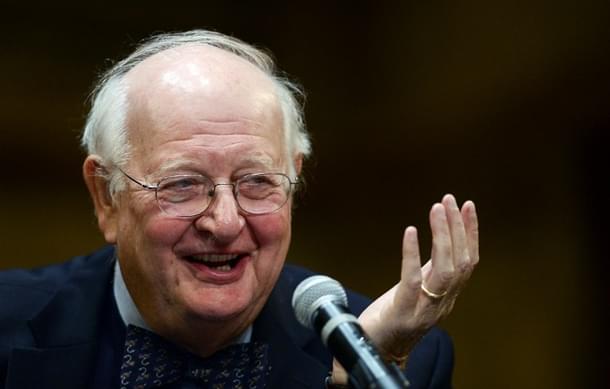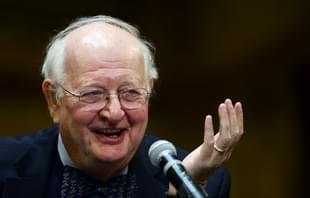Economy
Nobel 2015: All You Wanted To Know About Angus Deaton
Avinash Tripathi
Oct 16, 2015, 11:06 PM | Updated Feb 24, 2016, 04:26 PM IST
Save & read from anywhere!
Bookmark stories for easy access on any device or the Swarajya app.


Who is Angus Deaton? What is his contribution to economics? How useful is his work to real-life problems? All those questions and more, answered here.
The Nobel Prize in Economics (2015) has been awarded to Princeton scholar Angus Deaton. Understanding Deaton’s work requires a methodological excursion. Without knowing the state of research at the time when Deaton made his contributions, his body of work can not be properly appreciated.
Economists are interested in choices made by people. Much of economic theory is based on the assumption that human behavior, at least economic behavior, is rational. Rationality implies that consumers have well-defined preferences and constraints, and their choices are a result of optimization. The assumption of rationality is often contested. The trouble is that no one tells what an alternative framework might be like. When Hal R. Varian, now chief economist of Google, looked for some alternative all he could find was ‘random choice model’ pioneered by Gary Becker, which says that consumption decisions are made randomly!
Since rational decision-making in a sense is the only game in town, let us suspend our disbelief for a moment and try to understand where it might lead us. In economic models, preferences are usually represented by a utility function, constraints by a budget sets and actual choices by a demand system. Choices are observable while preferences can only be inferred. Observable demand system could be manipulated to yield something called the Slutsky substitution matrix. Rationality requires that this matrix be symmetric and negative semi-definite. Conversely any demand system that exhibits symmetry and negative-semi-definiteness can be inverted to yield well-defined preferences. So in a sense these are the only observable restrictions individual rationality imposes.
In economics, we are rarely interested in the behavior of a single individual. Most of the time we care about the behavior of a group of individuals say, residents of a country/state, those belonging to a particular ethnicity, gender, class, etc. A pertinent question is that if each individual behaves rationally, will the aggregate behavior of heterogeneous consumers itself conform to restrictions imposed by rationality? Theoretically speaking, the question was settled negatively during the seventies. In an extraordinary set of papers Gerard Debreu, Rolf Mantel and Hugo Sonnenschein proved that aggregation can potentially destroy rationality properties of demand systems (only very mild conditions like continuity and homogeneity of degree zero are preserved). In particular, almost any aggregate demand system, even the ones that do not yield symmetric, negative semi-definite substitution matrices, can be rationalized (that is why SMD is often called “Anything Goes Theorem”).

This technical result can be interpreted in two starkly different ways. A rather hostile interpretation would be that SMD proves that aggregate economics is non-falsifiable in the Popperian sense and, therefore, non-scientific. A more constructive interpretation would be that optimization and aggregation are very powerful techniques. They can generate and model arbitrarily complex behavior. Consequently, the right place for testing rationality assumptions is micro-level data (where aggregation related complications are absent, and rationality has a very convenient test: Afriat Inequality Violation). At the aggregate level, we need something more than individual rationality to generate sharp falsifiable predictions. We need to learn from the data.
It was precisely at this point Deaton entered the debate and almost revolutionized the art of demand estimation. To estimate demand system, we first need a parametric specification. Such a specification must meet both statistical and economic requirements. Statistically, its parameters should be easy to estimate, preferably using Ordinary Least Square (OLS). Economically, various rationality assumptions should imply testable restrictions on the model’s parameters and it should be able to approximate more complicated demand systems. Angus Deaton (together with J. Muellbauer) provided precisely such a specification known as Almost Ideal Demand system. The significance of this specification is difficult to overstate. In fact, Kenneth Arrow (arguably the greatest living economist) and others included this paper among 20 most influential articles ever published in American Economic Review in the last hundred years!
Lest the reader forms an opinion that demand estimation is only relevant for settling arcane academic disputes, let me hasten to add that demands systems are hugely important in applied work. They have enormous policy implications. Let me illustrate my point with two specific examples.
Recently, noted political scientist Pratap Bhanu Mehta argued that India should join Trans-Pacific Partnership. His arguments are political in nature. Mark the opening sentence “trade is almost never about trade”. But what if a trade is indeed about a trade? What is the economics of trade integration? Such integration may produce complex results, but as a first approximation, consumers benefit (due to cheaper prices and availability of a greater variety of goods) and some producers become worse-off (due to competition).
Before we can do any cost-benefit analysis, note the asymmetry here. We all know that the bottom line of a firm is profit. But what is the bottom line of a consumer? What is the monetary measure of consumer well-being and how can it be measured? One approximate measure is called consumer surplus, and its estimation requires fully estimated demand system. Suffice it to say that Deaton-type demand estimation plays an important part in computing welfare estimates.
Secondly, understanding how demand of particularly important goods varies with different covariates is important in itself. Deaton and Subramanian, using Indian consumption survey data, demonstrated that income elasticity of demand for calories is quite low and declines with increasing income. For every percentage increase in income, expenditure on calories rises by less than half a percent. When people get rich, they substitute more protein-rich diet, say pulses, dairy products, and meat, for cheap calories. This is significant as in most subsistence economies including India, calorie intake is considered as a proxy for welfare. At a minimum, this finding questions direct extrapolation from calorie consumption to well-being.
Understanding the dynamics of aggregate consumption is, of course, important in macroeconomics and Deaton has made important contributions here too. In macroeconomics, one abiding controversy has been about the relationship between income and aggregate consumption. J. M. Keynes believed that consumption should vary with current income. This was contested by many economists including Milton Friedman on the ground that in the presence of capital markets even futures earnings can be used for consumption. For example, a person can borrow against her future income and increase current consumption, paying out the loan later. So, the appropriate constraint consumers face is not current income but permanent income i.e. sum of future income streams appropriately discounted.
Deaton showed that variance of permanent income was larger compared to the variance of aggregate consumption. In other words, consumption is the lot smoother than theory says it should be. This finding is known as “Deaton paradox” in the literature. Deaton himself favors capital market imperfections like the presence of liquidity constraints to resolve this paradox. However, the paradox remains an area of active research.
In sum, Deaton’s research work can be summarized as a kind of structural empiricism. Even though his work is rigorously grounded in data, theoretical concern is always lurking beneath the surface. The field he helped pioneer (or inherited from his teacher Richard Stone) has come of age now. In our internet age, squeezing out every pattern from online transactions is a million dollar business. Huge datasets and enormous computing power are utilized. It is humbling to note that Deaton made most of his contributions when computing power was scarce; consumption datasets were hard to come by, and his research was driven mainly by academic curiosity. Maybe that explains why the Nobel committee has chosen to honor his work.
Avinash Tripathi is an economic researcher keenly interested in theory and institutional evolution of Indian economy




